-
Engine2.0L Turbo Boxer 4-Cyl
-
Power250 HP / 258 LB-FT
-
TransmissionCVT
-
DrivetrainAll-Wheel Drive
-
Seating2+3
-
MPG23 City / 28 HWY
My trip was so quick, I didn't even realize I was in Tokyo. Arrive Friday, drive Saturday and head home on Sunday. That's a brutal, sleep-depriving, time-zone-crimping turnaround, but I was game, because the 2014 Subaru Forester is an important product. In fact, in the last 15 years or so, it's arguably become the heart of the Japanese automaker's American range in our crossover-crazed nation.
Subaru had arranged a whirlwind tour to give a handful of journalists, including Autoblog, a chance to see, hear, touch and drive the new Forester before it goes on sale overseas this month. American dealers won't see this CUV until early next year, and we won't even get our first view of it in the metal and undisguised until the LA Auto Show in two weeks – we were only afforded a brief drive in disguised prototypes, so more in-depth impressions will have to wait until we have more time with the car.
Unbeknownst to Subaru, though, I was probably one of the few people it didn't want driving its new model – especially with jet lag. After all, I find the current Forester overrated and underpowered. Yes, it comes with a unique boxer engine, all-wheel-drive capability and hippies in sandals touting Subaru love, but still I detest it in all nine factory colors. Its oversized greenhouse, gangly stance and the tacked-on hood scoop on the turbocharged model has never sat well with me. To me, the Forester has always been a vehicle never quite done.
With this fourth-generation model, though, there are a slew of improvements that promise to make the Forester more palatable from looks to performance, though the addition of a new Continuous Variable Transmission on the spec sheet did cause me some consternation as I approached the Forester for the first time.
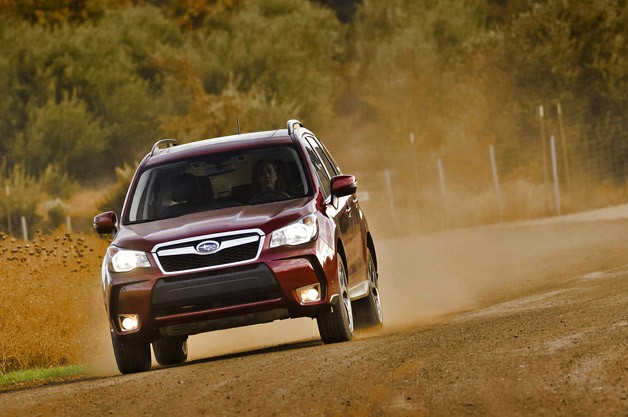
It can't be overstated: This vehicle is essential to Subaru's success. It represents about 25 percent of the marque's total sales. Here in the US, 22 percent of all Subarus sold this year have been Foresters – only the Outback outsells it. So it's gotta be good – really good in view of some of the mushrooming segment's newest competitors.
Like most redesigned vehicles, the Forester has increased in size with this latest generation. Engineers have made its track 0.8-inches wider, broadened its wheelbase by an inch and expanded overall length by 1.4 inches. It has even grown taller by over an inch. Despite this, Subaru has lowered the vehicle's center of gravity, a neat engineering trick considering the roof has been raised.Its center of gravity is lower, a neat engineering trick considering the roof has been raised.
Overall, these changes may seem minute, but they all play a role over the road, helping to give the Forester a stable, well-planted ride. That's not necessarily the sexiest compliment a vehicle can garner, but it's a seriously important attribute in this segment – and besides, a good ride is a good ride.
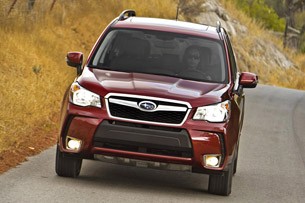
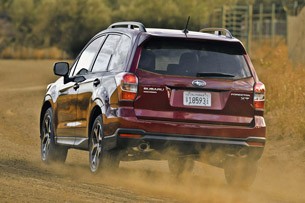
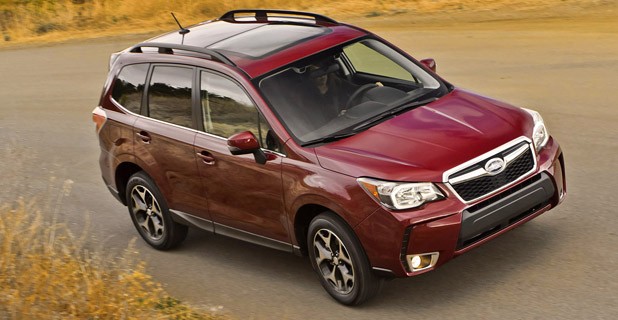
Unseen developments have had a big impact on quality of life inside the Subaru, too – additional insulators stuffed in more nooks and crannies do a lot to quell noise, vibration and harshness. One reason for my longstanding dislike of the outgoing Forester has been the unfortunate "hollow" sound that echoes throughout its cabin when driving on concrete roads. Those unpleasant noises will be eaten up by all of the sound-deadening materials now on board with this new model. Before, the Forester was like a Capitol Hill echo chamber full of useless din that only left this driver with a headache.
Also helping to eliminate unwanted squeaks and rattles, Subaru says it has improved the Forester's torsional rigidity by a whopping 150 percent, a fact most noticeable when we were taken over an off-road course with a professional driver. Even sliding through gravel and traversing big rocks, the Forester felt compliant and sure-footed, (though, admittedly, I wasn't behind the wheel).Subaru readily agrees this model changeover is more evolution than revolution.
Looking back and forth between new and old models, you can see they're different, but it's more difficult to point out exactly where the changes are on each vehicle. Look closer. Subaru readily agrees this model changeover is more evolution than revolution – an admission that reminds us of what Honda officials say when they rolled out their redesigned-for-2012 Civic. But unlike that car, which was universally thumped for decontenting, the Forester shows more maturity. It's grown up – it's not a cheaper version of itself, it's a better one.
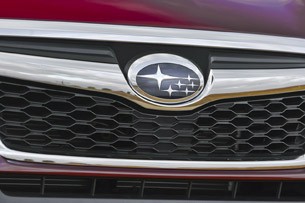
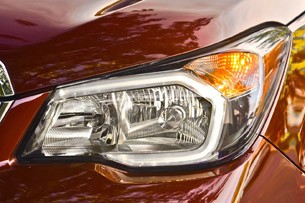
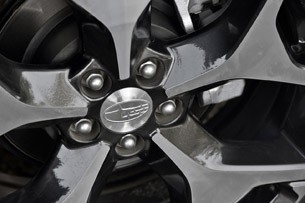
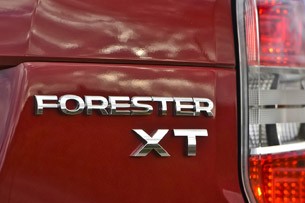
The hood adds a few crinkles, the headlamps have been replaced, the roofline has been reshaped with more slope to the back glass, all to make the Forester look sleeker to both onlookers and the wind. But the changes go beyond the superficial. The A-pillar has been pushed out by an inch, making the windshield a little steeper, resulting in improved visibility.
The turbocharged model loses its trademark hood scoop, also providing better aero. The loss of the top-mount intake is likely to jar some of the brand's faithful, but I think it's a big improvement. Curiously, this dramatic change on the outside didn't require moving the intercooler from atop the engine where it used to be fed by the scoop. Instead, Subaru just reworked the plumbing so air now comes to it from the front grille.The turbocharged model loses its trademark hood scoop, also providing better aero.
Other changes to the Forester's exterior include doors that extend down over the frame, with rocker panels now incorporated into the bottom of the doors. The reasoning behind this was simple: It makes it possible for drivers to enter and exit without getting their pant legs muddy from rubbing up against a dirty sill. Again, it's the maturity of this decision I appreciate. Sure, spinning tires through the dirt and ice is fun, but some of us still have to go to work without chunks of dried mud on our pants.
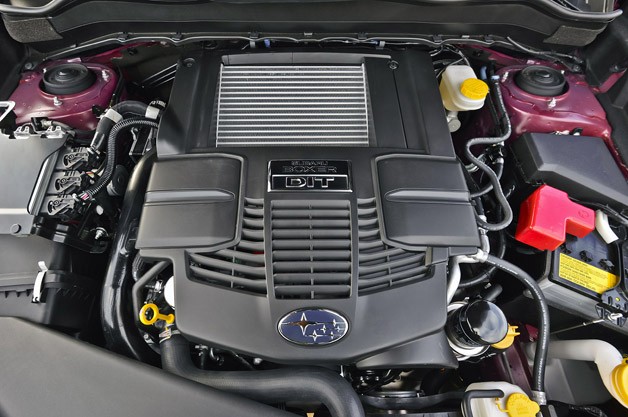
While the base Forester comes with the same 2.5-liter four-cylinder boxer engine that produces 170 horsepower and 174 pound-feet of torque, Subaru has added some fun with its new 2.0-liter direct injection turbocharged four cylinder. The latter ups the ponies under the hood from 224 horsepower on the outgoing engine to 250 and 258 pound-feet.
The base model is mated to either a six-speed manual transmission or the aforementioned CVT. The turbocharged model gets either a six-speed manual or CVT with paddle shifters offering eight "speeds." I'll admit right here to hating CVTs. I understand their usefulness in reaching higher fuel mileage numbers, something every automaker must strive for these days. But their shiftless driving and constant whining under load are loathsome.I quickly forgot that the turbocharged Forester even had a CVT.
And true to CVT form, when I took the base model with the pulley transmission around Subaru's double top secret test track, I kept waiting for the Forester to explode. It never did, but the whine of the engine on our preproduction test mule was disappointing. The acceleration was smooth and quick, but the sound didn't match up to the drive because the transmission would find the most efficient point in the powerband and then just stay there. It's unnerving. I'd opt for the manual every day of the week and twice on Sunday.
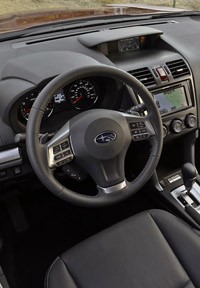
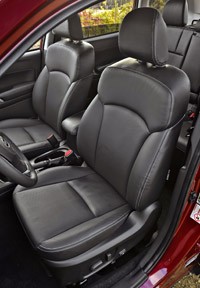
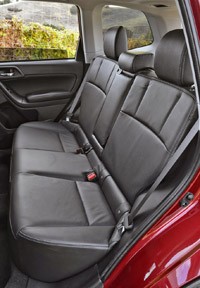
That said, I've also never liked programmed artificial shift points added to CVTs, they've always felt artificial. However, Subaru seems to have gotten it right. While the turbocharged model already starts out with the benefit of 80 more horses, the programmed-in shift points feel natural and direct. I hate to admit it, but I quickly forgot that the turbocharged Forester even had a CVT.
Subaru says that the new turbo four can perform nearly as well on regular gasoline, but it still recommends using premium fuel if you want to get everything out of it. Additionally, Subaru estimates that the base Forester will achieve 24 mpg in the city and 32 mpg on the highway. The turbocharged model will hit 23 mpg in the city and 28 mpg on the highway. Both are improvements over the outgoing models, figures that put Subaru squarely among the leaders in the compact crossover segment.Get inside and you'll instantly see, feel and touch the improvements.
Get inside and you'll instantly see, feel and touch the improvements. Perhaps my biggest gripe with the outgoing Forester was its lackluster interior. Thankfully, the new model's accommodations are most impressive. First of all, there's simply more interior space. By stretching and widening the body, the interior has gotten bigger. That space is well used, and the entire environment just looks and feels better. Instead of hard plastics at every sharp corner, there are soft touch points for your elbows. Both rows of seats have been rebuilt from the frame out and they're comfortable. Even the steering wheel feels more substantial. There are additional nice touches all over, including a rebuilt center stack that has good flow from top to bottom and a small screen between the gauges that provides additional driver information. In addition, Subaru has added Harmon Kardon premium audio and Aha radio integration.
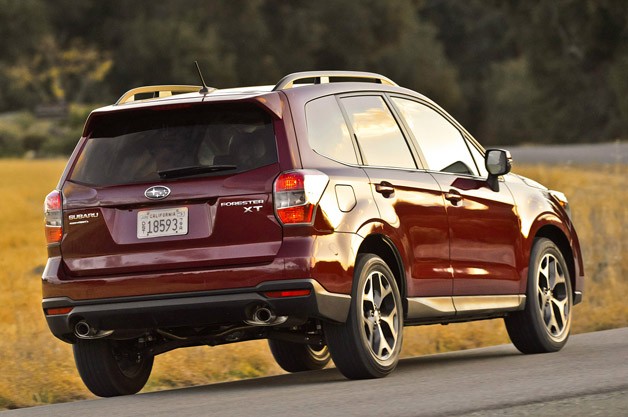
Really, the interior feels and looks much more grown up throughout. From its fold-flat second row to available options like a power height-adjustable liftgate and Subaru's new EyeSight safety system (it manages high tech safety features including adaptive cruise control and a lane departure warning system), the Forester never left us feeling like we were missing anything.
It's difficult to comment authoritatively on the new Forester's ride and handling. My time with it didn't amount to much more than a few laps on an oval track and a couple of laps on a curvy dynamic test circuit. For whatever it's worth, the steering weight was firm and I was pleasantly surprised how well the tires keep the Forester planted in corners. Its body never twisted or leaned too hard during aggressive cornering, and the all-wheel drive built confidence. Acceleration was quick enough to provide a few giggles, but that's not really the purpose of vehicles like this, right?the steering weight was firm and I was pleasantly surprised how well the tires keep the Forester planted in corners.
For its intended uses like driving kids to school, daily commutes, grocery runs and weekend getaways, the new Forester should perform admirably. Judging by our brief rendezvous in Japan, it's a good ride through and through. And even though our trip was short, this Subaru proved it was well worth the ride.
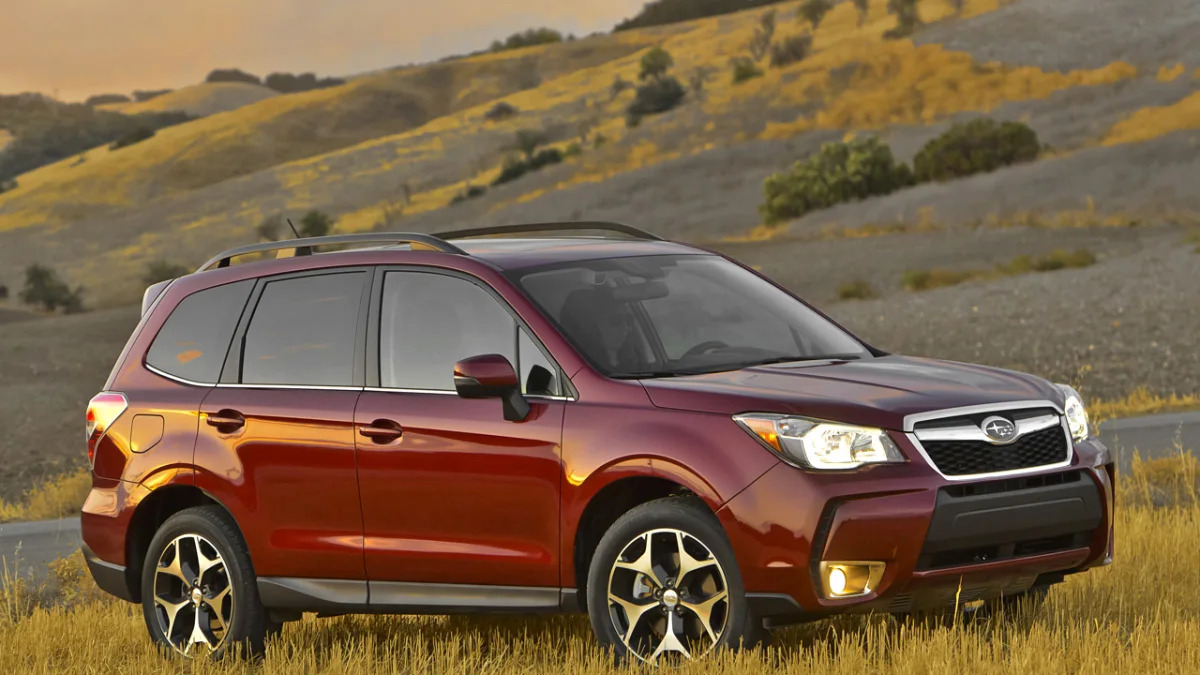









Sign in to post
Please sign in to leave a comment.
Continue